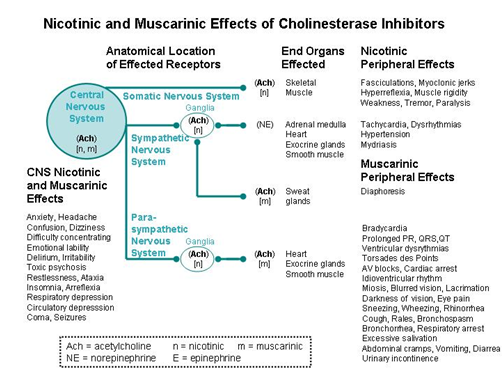Cholinesterase Inhibitors: Including Insecticides and Chemical Warfare Nerve Agents
Part 4: The Cholinergic Toxidrome
Section 1: What is the Cholinergic Toxidrome?
Course: WB 1098
CE Original Date: October 16, 2007
CE Renewal Date: October 16, 2010
CE Expiration Date: October 16, 2012
Download Printer-Friendly version [PDF - 1.88 MB]
Learning Objectives |
Upon completion of this section, you should be able to:
- Describe what causes the cholinergic toxidrome.
- Identify generally where cholinergic receptors are found.
- Identify the differences between nicotinic and muscarinic receptors.
- Identify why excessive levels of acetylcholine (the cholinergic toxidrome) cause different signs and symptoms depending on whether cholinergic receptors involved are of the muscarinic or nicotinic type.
|
Introduction |
The cholinergic toxidrome represents the acute phase of cholinesterase inhibitor poisoning.
It results from the accumulation of excessive levels of acetylcholine in the synapses, glands, smooth muscles, and motor end plates where cholinergic receptors are found.
Thus, the pathology of the cholinergic toxidrome (and the clinical picture that results) can best be understood with knowledge of the types of acetylcholine receptors, where they are located, and what physiological processes they modulate.
|
Types of Cholinergic Receptors |
There are 2 main types of cholinergic receptors, nicotinic and muscarinic, so named because their effects are similar to those of nicotine and muscarine.
The nicotinic and muscarinic receptors:
- Are present in different anatomical locations.
- Have different functions.
- Have different mechanisms by which they trigger signal transmission. (Erdman 2004)
|
Mixed Nicotinic and Muscarinic Effects |
In any given case, the patient's signs and symptoms may vary depending on the balance between sometimes apposing nicotinic and muscarinic effects. |
Summary Diagram of Signs and Symptoms |
Signs and symptoms of acetyl cholinesterase inhibitors --- and their relationship to nicotinic and muscarinic receptors --- are summarized in Figure 5 below. (Gershon and Shaw 1961; du Toit, Muller et al. 1981; Lotti 1992; Okumura, Takasu et al. 1996; Sidell 1997; Yokoyama, Araki et al. 1998; Reigart and Roberts 1999; Tareg, B et al. 2001; Erdman 2004) It is provided here, so that the reader can refer back to this figure as the topic is covered in further detail.

Figure 5. Summary diagram showing where nicotinic and muscarinic receptors are found. Refer back to this when reading the following sections.
|
Nicotinic vs. Muscarinic Effects |
The exact signs and symptoms found in any given individual with cholinesterase toxicity vary depending on the balance of nicotinic and muscarinic stimulation. |
Key Points |
- The cholinergic toxidrome reflects the acute phase of acetylcholinesterase poisoning.
- It is the result of inhibition of the enzyme acetylcholinesterase which normally breaks down the neurotransmitter, acetylcholine. The end result is the build up of excessive levels of the neurotransmitter.
- Symptoms are due to the effects of excess acetylcholine on nicotinic and muscarinic acetylcholine receptors in the CNS, at neuromuscular junctions, and in the sympathetic, and parasympathetic nervous systems.
- Nicotinic and muscarinic receptors have different
- Functions.
- Locations.
- Physiology.
- Structure.
|
| |
|
Progress Check |
|



